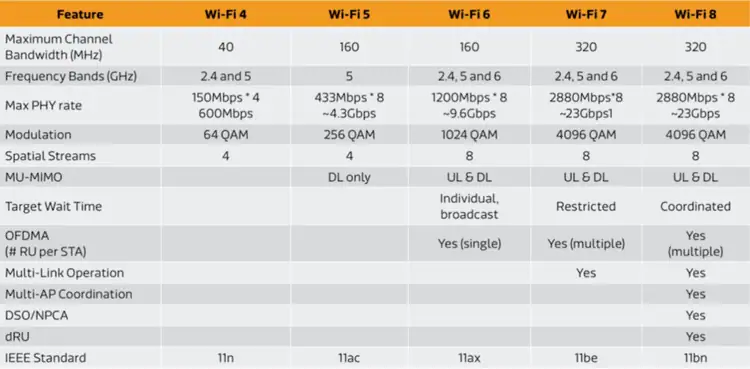The advent of WiFi 8 will bring new opportunities to the XR industry.
MediaTek has released a white paper on its official website outlining some details of the next-generation WiFi standard, WiFi 8 (IEEE 802.11bn). WiFi 8 will support the 2.4GHz, 5GHz, and 6GHz frequency bands, with a focus on improving effective throughput.
In the white paper, MediaTek highlights that actual WiFi throughput is significantly lower than the peak throughput observed in laboratory settings.
WiFi throughput is a key metric for evaluating wireless network performance and directly impacts user experience. Higher throughput allows users to download files, upload data, stream high-definition videos, or engage in real-time communication more efficiently.
Additionally, WiFi 8 will further optimize dynamic spectrum allocation technology, enabling the allocation of spectrum resources to different users based on network load and other factors. This will enhance system throughput and network capacity.
Notably, WiFi 8 will create new opportunities for the XR industry, making content transmission more efficient and reducing reliance on local processing power. This will accelerate the adoption and application of XR technology.
Devices supporting WiFi 8 are expected to hit the market in early 2028.

1. WiFi 5 remains dominant
According to the latest forecast by Counterpoint, WiFi revenue is expected to grow by 12% year-on-year in 2025. The surge in e-commerce, web browsing, and mobile learning has driven a shift toward high-speed internet, increasing demand for advanced connectivity. With the integration of nanotechnology, WiFi manufacturers are preparing faster and more efficient solutions to meet these needs.
WiFi 5 is projected to maintain a 56% market share in 2024, but the rapid rise of WiFi 6, 6E, and WiFi 7 standards signals a significant transformation. Together, WiFi 6, 6E, and 7 are expected to capture 29% of the market share in 2024, growing to 43% in 2025. This shift reflects a major transition from WiFi 4 to WiFi 5 and a growing demand for faster and more robust internet across multiple devices.
WiFi 7’s low latency will drive the emergence of new devices and facilitate smoother interactions with AI-enabled devices. Key advancements include:
- 320 MHz Ultra-Wide Channels: Available only on the 6GHz band, these double the transmission rate of WiFi 6 and support multi-gigabit speeds.
- Multi-Link Operation (MLO): Enables efficient load balancing between links, enhancing throughput and reliability.
- 4K QAM: Increases transmission rates by 20% compared to the 1024 QAM in WiFi 6, boosting efficiency.
- 512 Compressed Block Acknowledgments (Ack): Improves efficiency and reduces overhead.
- Multiple RUs to a Single STA: Enhances flexibility in spectrum scheduling, improving spectrum efficiency.
2. Increasing WiFi 7 adoption; market penetration to exceed 50% by 2027
According to Gartner, WiFi 7’s market penetration is expected to reach 10% in 2024 and surpass 50%, reaching 54%, by 2027. MarketDigits estimates that the compound annual growth rate (CAGR) for WiFi 7 between 2023 and 2030 will exceed 50%, with the market value reaching $26.2 billion.
Industry observations indicate that while it typically takes 4-5 years for new wireless technologies to transition between generations, market-driven factors have significantly accelerated adoption rates in recent years. MediaTek noted that WiFi 6 achieved a 50% market penetration within just three years of its 2019 launch. Each individual is expected to own over six WiFi-enabled devices in their lifetime, underscoring an optimistic outlook for WiFi 7.
The COVID-19 pandemic spurred demand for remote work and learning, prompting brands and telecom operators to upgrade directly to WiFi 6 to meet market needs. As the market transitions from WiFi 6 to WiFi 6E, the rise of AI and the proliferation of AIoT and other IoT devices will further accelerate WiFi 7’s growth.
Industry experts predict that WiFi 7-related products will enter mass production in the latter half of this year, with shipments increasing significantly in 2025. The key to WiFi 7’s widespread adoption lies in pricing. Once the cost difference between WiFi 7 and WiFi 6 narrows, upgrades will accelerate across telecom, enterprise, and consumer sectors.
AI PCs and flagship smartphones are already supporting WiFi 7. Market speculation suggests that Apple’s upcoming iPhone 16 will likely support WiFi 7, driving the upgrade of the entire WiFi 7 industry chain and boosting opportunities for companies such as MediaTek, Realtek, Wistron NeWeb, Zyxel, and more.
The iPhone 16 series is expected to feature WiFi 7 chips supporting 2.4GHz, 5GHz, and 6GHz frequency bands, with transmission speeds projected to reach 40Gbps—four times that of WiFi 6E. It is also likely to adopt the 5G Advanced standard, achieving simultaneous upgrades in both 5G and wireless transmission speeds.
Related:

Disclaimer:
- This channel does not make any representations or warranties regarding the availability, accuracy, timeliness, effectiveness, or completeness of any information posted. It hereby disclaims any liability or consequences arising from the use of the information.
- This channel is non-commercial and non-profit. The re-posted content does not signify endorsement of its views or responsibility for its authenticity. It does not intend to constitute any other guidance. This channel is not liable for any inaccuracies or errors in the re-posted or published information, directly or indirectly.
- Some data, materials, text, images, etc., used in this channel are sourced from the internet, and all reposts are duly credited to their sources. If you discover any work that infringes on your intellectual property rights or personal legal interests, please contact us, and we will promptly modify or remove it.



